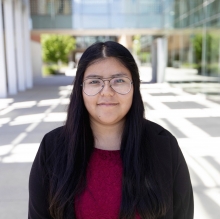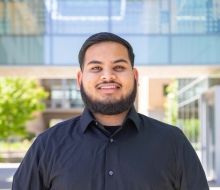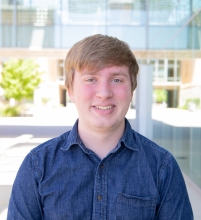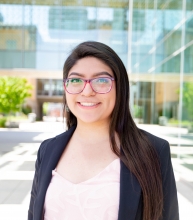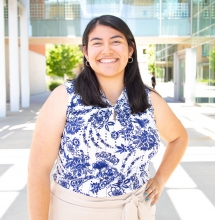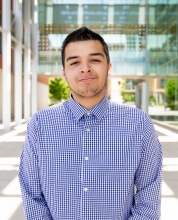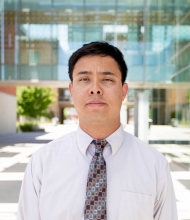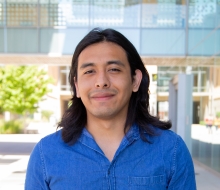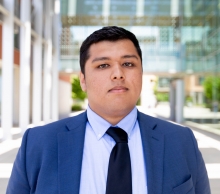Giovanni Alvarado
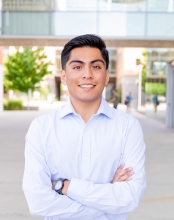 |
Major: Psychology
Home City: Los Angeles, CA
Contact: galvarado5@ucmerced.edu
Faculty Mentor: Matthew J. Zawadzki, PhD
|
Giovanni Alvarado is a fourth year undergraduate student from Los Angeles, CA who is expected to graduate in Spring 2020 with a major in Psychology. He currently works as a library student assistant for the UC Cooperative Extension Project, is an intern for the Nicotine and Cannabis Policy Center, and is also a research assistant in both Dr. Wiebe's Lab and Dr. Zawadzki's Stress and Health Lab. In the fall of 2019, he will also be working as a research assistant in Merced's Experimental Social and Health (MESH) Psychology Laboratory. During his free time, he enjoys playing various sports such as basketball, football or soccer and loves attending Lakers basketball games. In the near future, he plans to pursue a PhD in health psychology and work at an institution to continue expanding on his research interests. His goal is to inspire his siblings and other first generation students to pursue a degree in higher education so they could make a lasting impact in our society.
The Relation Between Perceived Stress, Burnout and Worry on Sleep Quality
Giovanni Alvarado, Larissa Gavrilova, and Matthew J. Zawadzki, PhD; School of Social Sciences, Humanities, and Arts, University of Calfironia, Merced
Ample research links stress with poor sleep quality. Several conceptualizations of stress exist: perceived stress is the extent to which an individual perceives a situation as stressful, burnout is the state of emotional/physical/mental exhaustion caused by prolonged/excessive stress, and worry is the state of mental distress due to an anticipated event. Little research has tested whether these types of stress are unique or are different ways of assessing the same construct. The purpose of this study is to examine whether perceived stress, burnout, and worry independently predict sleep quality. We collected data from 280 employees from the University of California, Merced (71 males, 208 females) with a mean age of 37.3 years. Participants filled out the following measures online using the online platform Qualtrics: Perceived Stress Scale, Bergen Burnout Inventory, the Penn State Worry Questionnaire, and the Pittsburgh Sleep Quantity Index (we focused on the component assessing overall sleep quality over the last month. First, we expect to see an inverse relationship between each of the three types of stress and sleep quality. We also anticipate that perceived stress, burnout, and worry will be independently correlated with sleep quality. These findings will aid in developing treatments/habits to diminish stress levels and improve individual’s health-related quality of life.
Mariamawit Belette
 |
Major: Public Health
Home City: San Diego, CA
Contact: mbelette@ucmerced.edu
Faculty Mentor: Irene H. Yen
|
Mariamawit Belette is a fourth year undergraduate student from San Diego, CA. Expected to graduate in Spring 2020 with a BS in Public Health and a minor in Psychology. Mariamawit has participated in research during her time at UC Merced in the Stress and Health Lab as well as being an active member in her community. As a member of Public Health Society and UC Sprouts, she believes it is important to address broad issues that can affect health and well-being of populations and work towards improving and protecting community health. In her spare time she likes to go hiking. She aspires to achieve her master’s degree in Health Communication.
Housing Insecurity and Health Outcomes in Rural United States
Mariamawit Belette, Shaina Sta. Cruz, and Irene Yen, PhD; School of Social Sciences, Humanities, and Arts, University of California, Merced
Past studies have found rural communities to have worse health outcomes than urban areas. Housing related disparities are of great concern in rural communities. A lack of stable, affordable and adequate housing can have severe implications for a person's health. In this systematic review of literature, I seek to understand the associations between housing insecurity and selected health risk behaviors and outcomes in rural United States. Through the Social Sciences Combined database, I gathered and analyzed peer reviewed articles that researched housing insecurity, health outcomes, and rural health. Findings show health is affected by housing conditions in most rural areas. From my review of literature, I found there has been little research done on housing insecurity in rural areas. Due to limited studies in this area, it is important to continue more research to better understand housing-health inequities in rural areas.
Kanani Boyd
Kanani Boyd is a third-year undergraduate student from San Francisco, CA. She is expected to graduate in Spring 2020 with a B.A. in Psychology and two minors, one in Cognitive Science, the other in Community Research Service. She plans to pursue a Ph.D. with the intent on one day becoming a professor. With the increased prevalence of vaping and the legalization of cannabis, she hopes to conduct research that influences policies that combat health disparities in minority communities while improving overall health. As she makes these accomplishments she desires to be an inspiration especially to young women of color.
Exposure to Secondhand Smoke in San Joaquin Valley
Kanani S. Boyd, and Mariaelena Gonzalez, PhD; School of Social Sciences, Humanities, and Arts, University of California, Merced
Research shows that exposure to secondhand smoke (SHS) poses significant health risks. However, there is a lack of research on where the general public is exposed to SHS or the general public’s support for smoke-free air laws (SAL) not covered by state law in the San Joaquin Valley (SJV). We hypothesize that the pattern of exposure to SHS and support for SAL will differ by sex, race, ethnicity, age, sexual minority status, and county. Residents from 11 counties in the SJV were surveyed in the spring and summer of 2019. Frequencies and crosstabs would be used to examine data. High rates of exposure to SHS were reported in public places with parks and outdoor areas holding the highest reported exposure. Approximately 46% of 125 respondents believe that smoking should not be allowed in public parks. Results could determine which groups should be targeted for health interventions to prevent negative health outcomes in these communities. Conclusion will be determined based on results.
Alondra Calderon
Alondra Calderon is a third year first generation undergraduate student from Porterville, CA. She is expected to graduate in Spring 2021 with a BA in Political Science. Her main goal is to get a Ph.D in order to do her own research and become a professor someday. Alondra is also currently double minoring in Psychology and Cognitive Science to help with her field work more on how politics and individuals coninside. Alondra’s main goal is to teach younger generations that come from similar households and circumstances that college can be achievable through hard work and determination. Now conducting her own research, becoming vice president of Best Buddies, being a Fiat Lux Scholar, and a UC Merced Campus Tour Guide, she has already begun to leave her mark here at UC Merced.
The Financial Stress of College Students
Alondra Calderon, and Elaine Denny, PhD; School of Social Sciences, Humanities, and Arts, University of California, Merced
In the University of California, Merced, it was reported in the 2019 year alone 52.3% of students were struggling with handing financial stress and 42.1% struggling with overall stress. Even more, evidence suggested that students tend to have trouble with adjusting and fully being able to finish college because of overall stress put upon them. The purpose of this research is to understand the importance of the stress in students in order to find methods of coping and adjusting resources. An analysis done through this research showed that college students do tend to be less academically successful than those with coping resources obtainable. Researchers job is to find the right mechanism to improve not only resources to deal with stress, but also how to adequately provided that resources to students.
Victor Castro
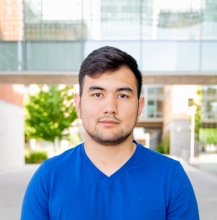 |
Major: Molecular and Cell Biology
Home City: Fontana, CA
Contact: vcastro7@ucmerced.edu
Faculty Mentor: Stephanie Woo
|
Victor Castro is an undergraduate at UC Merced who started in Fall of 2016 and who plans to graduate in Fall of 2020. After joining a genetics/developmental biology lab on campus, he learned that doing research is a career he wants to pursue and plans on continuing his education and to obtain a Ph.D. in that area. In addition, he also has goals of becoming a certified commercial airline pilot and becoming a certified scuba diver. During his free time, Victor enjoys visiting a variety of restaurants and constantly trying new steaks. He also goes to Denny’s multiple times a week just to have a coffee.
Septin9b CRISPR Mutants
Victor Castro, and Stephanie Woo, PhD; School of Natural Sciences, University of California, Merced
The Septin family of proteins are fundamental for a variety of biological processes within the cell. These include acting as scaffolds and diffusion barriers, their contribution to the rigidity of the cell and vesicular fusion, as well as their interaction with phospholipid membranes, actin filaments and microtubules. Although the Septin family has been known for over forty years, much is yet to be discovered about their interaction and importance within living organisms, including the diseases associated with their malfunction. In an attempt to decipher its function within living organisms, the Woo lab successfully raised CRISPR mutants of the Septin9b gene in zebrafish by both the introduction of an early stop codon knock-in or short 5 base-pair deletion. However, no phenotypic changes were seen in the fish. Here, we attempt to prove that mRNA levels of Septin9b are much lower in those fish than those of a wild-type line through the use of techniques such as RNA extraction, synthesis of cDNA and RT-qPCR.
Ahquib Choudhury
Ahquib Choudhury is a fourth-year undergraduate student from Oxnard, CA. Ahquib is expected to graduate in Spring 2020 with a BS in Biology with a human emphasis. Ahquib is part of Pi Lambda Phi fraternity on campus where he holds the Vice President of Risk and Management position in the fraternity. This is Ahquib first year conducting any research on campus and he is very excited about what is in store for the future. Ahquib thinks it is important to be able to learn and gain as much knowledge as possible in these four years of his undergraduate. He also thinks it is important to make many connections with his peers, colleagues, professor, and staff on campus because using the resources on campus and making these connections will open up opportunities for him in the future post-graduation. Ahquib plans for post-graduation is to be able to get his master in biology and work in the industries until other opportunities open up for him. Ahquib ultimate goal in life is to be able to hold a stable job and build a family which he can support them comfortably and allow his children with many opportunities also for them to succeed in life. His biggest role model in life is his mom. Ahquib quotes "everything I do in life, I do for my mom. She is my biggest inspiration and supporter. I hope to pay her back for all the sacrifices she has made for my siblings and me".
Oxalobacter spp. C1 Bacteriophage Isolation using Mitomycin C Induction
Ahquib K. Choudhury, Christopher J.R. Turkington, PhD, and Juris A. Grasis, PhD; School of Natural Sciences, University of California, Merced
The basal metazoan Hydra spp. are freshwater animals that have a naturally occurring microbiota. To experimentally explore the symbiotic relationship between bacteria and viruses in Hydra spp., bacteria and bacteriophages to be used as experimental models must first be isolated. Prior to this study, a strain of bacteria Oxalobacter spp. C1.1 was isolated from the Hydra vulgaris, and therefore in the current work the objective was to isolate a bacteriophage associated with this organism. Bacteriophages can either lyse bacteria directly or integrate their genome into the bacterial genome as so-called prophages, where they remain at a silent state. By using of induction methods, this latter form of bacteriophage can be forced to excise from the bacterial chromosome forming viral progeny that can then be collected. Induction can be stimulated by stressful condition such as by damage to the bacterial DNA, this can be done with experimentally using DNA damaging antibiotics, such as mitomycin C. We therefore exposed Oxalobacter spp. C1.1 to three concentrations of mitomycin C (0.0156 µg/ mL, 0.0039 µg/ mL, and 0.000488 µg/ mL). At the higher concentration of mitomycin C (0.0156 µg/ mL) declines in bacterial density was observed, indicating the lysis of bacterial cells, and therefore possible bacteriophage induction. As the overall goal of this work is to identify bacteriophages for Oxalobacter spp. C1.1.
Ethan Custodio
Ethan Custodio is a third-year undergraduate from the town of Sutter Creek, California. Expected to graduate in Spring 2021 with a B.S. in physics, he intends to earn a PhD in theoretical physics with the goal of becoming a university professor. He hopes to be able to help teach the next generation of scientists and continue to forward the field of physics. In addition to conducting research, he is an officer for the UC Merced chapter of the Association for Computing Machinery, a club that helps students learn new programming skills and connect with one another. In his free time Ethan enjoys cooking interesting food, reading, and stargazing.
Finding Hyperbolic Plateau of Topological Entropy in a chaotic Rydberg Atom
Ethan T. Custodio, and Kevin Mitchell, PhD; School of Natural Sciences, University of California, Merced
Placing a classical hydrogen atom in an external magnetic field creates a chaotic system. The dynamics of the electron can be described with a Hamiltonian. A surface of sections plot is created from the Hamiltonian to visualize the dynamics on a two-dimensional Poincaré surface with the magnitude of the external magnetic field and electron energy as parameters. Using a monte carlo simulation and millions of orbits the escape rate of the electron can be computed at different parameters; however, if a complete symbolic dynamics can be extracted from the system we can compute the same escape rate with only thousands of special, periodic orbits. But, at different parameter ranges the symbolic dynamics can either be clearly defined or become incredibly complicated. Using homotopic lobe dynamics we predict what the symbolic dynamics will be at one of the hyperbolic plateaus. By analyzing the topology of the unstable manifold at different parameter values we conduct a binary search of the parameter space to find these regions of relatively stable topological entropy, called hyperbolic plateaus. We expect to find this region and then continue to search for additional plateaus with different predictions. In the future we will compute the periodic orbits in these regions and use them to calculate escape rates.
Natasha Galicia
Natasha Galicia is a rising fourth year undergraduate student from Hayward, CA. She is pursuing a degree in Political Science with a minor in Global Arts Studies. Her interests include learning about human rights and social movements and is intent on pursuing a Ph.D. upon her graduation in spring of 2020. In the future she looks forward to becoming a resource for students of underserved communties to pursue their professional aspirations by providing program support and counseling. During her time at the UC she has held positions within different organizations including Brown Issues and Lambda Theta Nu Sorority, Inc. and wishes to continue strengthening her relation with the community by being proactive and attent to the needs of youth. In her free time, she enjoys exploring, finding a good place to eat, and spending time with family and friends.
The Phsycial Signs of Gentrification and Racial Turnover in Washington, D.C.
Natasha P. Galicia, and Tanya Golash-Boza, PhD; School of Social Sciences, Humanities, and Arts, University of California, Merced
In 1970, 70% of the population of Washington, DC identified as Black. The Black population has steadily declined since, and in 2014, Black people were no longer the majority in the capital city. Since the beginning of the 21st century, the city has seen an increase in median household income and housing prices. This study sets out to identify the change in physical appearance in the city as it gentrifies and experiences racial turnover. The data was collected through a housing survey and was analyzed through ArcGIS, a geographic information analysis tool, to visualize the variables and create a map that displays the area studied. The area under study is a census tract that has experienced a decline in Black residents since 1990 yet little change in median household income. This study of the change in the physical characteristics of the neighborhood reveals both public and private investment in the neighborhood, despite the lack of change in median income. We plan to use these observations to develop a model to measure the correlation between public and private investment, racial turnover, and gentrification in Washington, DC.
Jacqueline Guerrero
Jacqueline Guerrero is currently a fourth year undergraduate student from Atwater, Ca. Jacqueline is expected to graduate in Spring 2020 with a B.A. in Public Health and a minor in Management and Business Economics Minor. She believes in promoting the overall health and well-being in a community by volunteering at the Merced County Department of Public Health. In her free time, Jacqueline enjoys concerts, running, watching soccer, and spending time with her family. She aspires to achieve a Master's or PhD in Public Health and help underprivileged communities.
Seasonality of Aedes aegypti Mosquito (The Zika Mosquito) in Merced
Jacqueline Guerrero, and Andrea Joyce, PhD; School of Social Sciences, Humanities, and Arts, University of California, Merced
Aedes aegypti is a mosquito which can transmit dengue, chikungunya and Zika viruses. This mosquito is typically found in tropical areas, but has been introduced into California, and was detected in Merced County in the fall of 2017. Since the mosquito is new to Merced, it is important to understand the seasonal abundance of this mosquito and educate the public about its potential public health importance. The purpose of this study was to understand what months during the year the mosquito will be most abundant. This information will help to target control efforts to reduce mosquito populations. Understanding when the mosquito is most abundant will also inform education efforts for the public, to provide information for when they most need to protect themselves from the mosquito. A study was conducted in Merced to monitor the year-round egg laying (oviposition) activity by this mosquito. Fifty egg traps (ovitraps) were set each week during the year, 2017-2018. Traps were checked each week for eggs. Eggs were photographed and counted to determine the average number of eggs oviposited each week. From this data, we will determine which weeks and months have mosquito activity and when the mosquito is most abundant. This will provide information to the Merced County Mosquito Abatement and the Department of Public Health, to help target control and education efforts against this mosquito.
Jacqueline Hernandez Contreras
As a first-generation university student, Jacqueline Hernandez Contreras is a second-year undergraduate born in Stockton, CA. She is on the path of completing a BS in Human Biology with the expectation to graduate in Spring 2021. With a curiosity of learning more about the holobiont of prokaryotic and eukaryotic cells in association of viruses, she aims to recognize a virus’s ability to harmoniously live with its environment and potential weapon to contradict against harmful diseases. Jackie believes that knowledge is a universal key to change, progress, and personal growth. Therefore, she intents to motivate her community to participate in educational programs by volunteer in Music Summer programs and giving her testimony as a first-generation college student. In stressful situation, she loves to ride her bike, shopping with her friends, and going to the library. Jackie strives to accomplish a PhD in Immunology with the ultimate goal of traveling to help the impoverished communities to live a healthier enviroment.
Isolation of Temperate Bacteriophage in Acidovorax spp. AEP 1.4
Jacqueline Hernandez Contreras, Christopher J.R. Turkington, PhD, and Juris A. Grasis, PhD; School of Natural Sciences, University of California, Merced
A temperate bacteriophage can interact with a host bacterium by imbedding its viral genome into the host’s chromosome, existing as a prophage. Under normal conditions, a prophage remains in the bacterial chromosome meaning the bacterium and temperate bacteriophage live in a mutualistic relationship. However, if exposed to stress stimuli, such as mitomycin C, an antibiotic that inhibits bacterial growth through DNA damage, prophage can then lysis the infected bacteria. Therefore, stress stimuli, such as mitomycin C, can be used in the laboratory to isolate temperate bacteriophage inside bacterial genome. Here, Acidovorax spp. AEP 1.4, a bacterium extracted from Hydra vulgaris, was examined for the presence of temperate bacteriophage by the introduction of mitomycin C into cultures of the bacteria, with measurement of declines in bacterial density being used to indicate the presence of bacteriophage in the host. For this Acidovorax spp. AEP 1.4 was exposed to three mitomycin C concentration (2 μg/mL, 0.5 μg/mL, and 0.0625 μg/mL), it was found that 2 μg/mL mitomycin C caused decline of bacterial growth after 10 hours, suggesting possible bacteriophage lysis. To confirm this observation examination of the filtrate form, these culture under TEM (transmission electron microscope) will be used to image any bacteriophage produced. In conclusion, the bacteria growth decline indicates potential bacteriophage lysis, and therefore possibly isolation of bacteriophage of Acidovorax spp. AEP 1.4.
Derek (Sang) Hoang
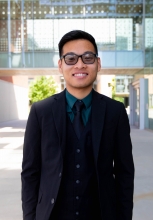 |
Major: Management and Business Economics
Home City: San Francisco, CA
Contact: shoang27@ucmerced.edu
Faculty Mentor: Justin Hicks
|
Sang Derek Hoang is a fourth year undergraduate student from San Francisco, CA. Expected to graduate in Spring 2020 with a B.S. in Management and Business Economics, Hoang is leaving his legacy at the University of California, Merced by conducting research and being an actively engaged member in his community. He is the President of the Marketing Club and Economics Club, President and Captain of the Men's Lacrosse team, and the Outreach Director of the Microfinance Project. To destress, Hoang finds himself watching sports, reading books, and traveling to new places. He aspires to achieve a Ph.D in Economics with an emphasis in Applied Econometrics, and his ultimate goal is to be a man who can inspire youth from the Tenderloin District in San Francisco and Vietnam to pursue higher education.
Stock Prices and Investor Information Availability
Sang H. Hoang, and Justin J. Hicks, PhD; School of Social Sciences, Humanities, and Arts, University of California, Merced
Information and investment decisions are directly related according to all fundamental models of corporate finance and economics. As such, this study proposes a direct measurement of capturing investor information with the use of Google Trends - Search Volume Index (SVI). We sampled the SVI of companies in the S&P 500 and their monthly stock prices; and monthly closing stock prices extracted from the University of Pennsylvania’s Wharton Research Data Services database (WRDS). We ran a time-series regression from 2008 to 2018 and find that there is a significant relationship between SVI’s web searches and the price of a stock 2 to 4 months from the time the search index makes a major change. The relationships between the SVI and the stock’s monthly price is negative and statistically significant at the 2 month lag. In our findings, a 3 standard deviation increase in web searches leads to a .48 dollar decrease in stock price 2 months out, controlling all attributes of the firm. The implications of this research findings confirm that Google Trends’ Search Volume Index can predict stock prices.
Daren Huang
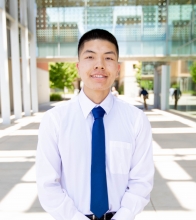 |
Major: Public Health & Psychology
Home City: San Francisco, CA
Contact: dhuang25@ucmerced.edu
Faculty Mentor: Sidra Goldman-Huang
|
Daren Huang is a fourth year undergraduate student from San Francisco, CA. Expected to graduate in Spring 2020 with a BA in Public Health and Psychology, Daren’s long term goal is to pursue higher education in graduate school specifically achieving a PhD. Other than research at UC Merced, Daren is involved in an on campus organization known as Delta Epsilon Mu, a professional pre-health co-ed fraternity where he currently holds an executive board position. During his free time, Daren loves to go to the gym, run, play sports, and watch YouTube videos. As a senior, his ultimate goal is to use his health-related knowledge to teach his peers and colleagues and inspire each and every individual to aim high.
Geographic Variation and Trend in ED Visits among Adolescen Suicide, Alcohol, and Drugs within all Counties in California
Daren Huang, Kevin Kwan, MSPH, and Sidra Goldman-Mellor, PhD, MPH; School of Social Sciences, Humanities, and Arts, University of California, Merced
According to the CDC, suicide rates went up by 30% in half of the states since 1999. Due to easier access to substance abuse, nearly half of the adolescents in high school have tried alcohol, marijuana or cigarettes (CDC, 2019). By looking at ED visits for self-harm, alcohol use, and drug use, research is needed to provide a clearer understanding of whether county-level rurality, economic region, and median household income influence rates of ED visits for substance abuse and self-harm. Data from the Office of Statewide Health and Planning Department (OSHPD) was utilized for this study. 4 different quartiles were divided to examine the rate of median household income level in California. In addition, 9 different economic regions in California were explored. Lastly, rural areas by county was compared to urban areas. The household income results showed lower income counties who made less than $53,000 had higher rates for all three behaviors. As far as regions, Northern California regions are more prone to self-harm, alcohol and drugs. Finally, urban counties had higher alcohol and drug use rates, whereas rural counties experienced more self-harm among adolescents. Overall, these longitudinal trends showed the need for suicide prevention, self-harm related ED interventions and treatment programs in less fortunate counties.
Noah Huerta
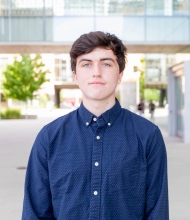 |
Major: Biological Sciences
Home City: San Luis Obispo
Contact: nhuerta6@ucmerced.edu
Faculty Mentor: Anna Beaudin
|
Noah Huerta is an undergraduate student at UC Merced who has just completed their sophomore year and is expected to graduate in the Spring of 2021. Noah is an employee of the Chemistry center and works to help other students in undergraduate chemistry courses. Noah has just begun to conduct undergraduate research working to map the pathways of tissue-resident macrophages and hopes to graduate with a degree in molecular and cell biology. He hopes to one day obtain his Ph.D. in a biology field and then contribute to research.
IL-7R Promotes Survival and Proliferation of Tissue Resident Macrophages
Noah T. Huerta, Gabriel Leung, and Anna Beaudin, PhD; School of Natural Sciences, University of California, Merced
Interleukin 7 receptor (IL-7R) signaling is essential for the survival and proliferation of T cells as well as the proliferation of B-cells. Our lab has recently discovered that IL-7R signaling is required for tissue resident macrophage establishment during fetal development, but the function of Il-7R signaling in macrophage development is still unknown. We hypothesize that tissue-resident macrophages use the IL-7 receptor for both survival and proliferation because it has similar functions in lymphocyte development. To determine its function, we blocked the receptor using a highly specific blocking antibody administered during the fetal developmental window when the receptor is expressed. The next day, at E16.5 immune cells were isolated from the brain, liver, lung and skin and assessed for proliferation by staining with the proliferation marker Ki67, or for apoptosis by staining with Annexin V. Preliminary results suggest that IL-7R signaling affects both macrophage proliferation and survival across multiple tissues, but ongoing studies aim to confirm this initial finding. This data suggests that IL7-R regulates specific developmental processes during fetal macrophage development and confirm the requirement for IL-7R signaling is tissue resident macrophage establishment.
Andgielika Katlaina Sales
 |
Major: Public Health
Home City: Stockton, CA
Contact: asales@ucmerced.edu
Faculty Mentor: Denise Payan
|
Andgielika Sales is an incoming fourth year undergraduate student from Stockton, CA. Andgie applied for UROC in hopes to take a step further in her future career in getting a Ph.D in Public Health or Public Administration. Her current involvements include volunteering at the Merced County Public Health Department in the Prevention, Policy, & Planning Department, interning at UC Merced’s Campus Activities Board where she has exemplified her leadership skills in planning and executing campus-wide events, whilst also being actively involved in her community volunteering on her free time, and working at the university Career Center which has helped her expand her network and polished her professional skills. In her past high school career, she found interest in helping her community and passion in Public Health through the Students In Prevention program which raised awareness in mental health, suicide prevention, and drug use. She hopes to be able to continue her momentum in community involvement throughout her future. As a native citizen of the Philippines, Andgie hopes to return to her home country and use her education to improve the Public Health Department by making nutritional information and resources more accessible to lower-income families.
A Qualitative Research Study Exploring Physician Decision-Making and Addressing the Physician Shortage in the Central Valley
Andgielika Katlaina C. Sales, Denise Payan, PhD, and Rosa Manzo, PhD; School of Social Sciences, Humanities, and Arts, University of California, Merced
The physician shortage is a critical problem in the Central Valley contributing to delays in healthcare access and disparities among residents. To the best of our knowledge, research has not been conducted on solutions. Possibly the lack of support, attention, and finances may have been the factors as to why we are currently having this problem. In the literature, medical students and residents trained and exposed to rural settings are more likely to choose practice in the region and to specialize in family medicine. Among females, a partners’ location is an identified barrier to practicing medicine in rural settings. This qualitative study explores barriers and facilitators influencing students’ and residents’ decisions to work in the Central Valley. Interviews were conducted with 12 participants and were about twenty minutes to an hour long in duration. The purpose of the data collection instruments was to understand the views and experiences related to students' and residents' training and to explore if pipeline programs and mentorship programs influenced their decision-making. NVIVO, a qualitative data analysis software, was used to analyze key themes in the interviews. Respondents revealed a lack of mentorship models in their field. They shared that prior exposure to the medical field was an important factor encouraging them to pursue a career in medicine.
Raymond Kim
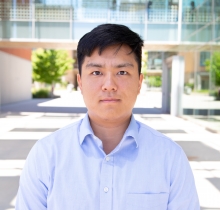 |
Major: Economics
Home City: Lakewood, CA
Contact: rkim57@ucmerced.edu
Faculty Mentor: Rowena Gray
|
Raymond Kim is an upcoming fourth year undergraduate student from Lakewood, CA. He is expected to graduate in Spring 2020 with a BA in Economics and a minor in Cognitive Science. He was first introduced to research during his second year as a research assistant at the Health Communications and Interventions Lab. Since then, he has worked as a Student Success Intern and is involved with projects on campus such as Merced Energy and Neural Finance. He wants to pursue either a PhD or Masters in Statistics and devote his life to research.
Analyzing Minimum Wage Tasks and Occupations from 1940 to 2000
Raymond Kim, Liza Oh, and Rowena Gray, PhD; School of Social Sciences, Humanities, and Arts, University of California, Merced
A temporal mapping of minimum wage tasks leads to a better understanding of labor market history and allows us to possibly forecast future labor market changes. To create this, the study identifies what types of tasks and occupations were compensated minimum wage from 1940 to 2000. The expectation is that routine tasks become less valued over time with the advent of automation. This study augments Census data containing wage and occupation information from 1940 to 2000 to include task data provided by the Dictionary of Occupational Titles. This study also utilizes federal and state minimum wages to identify minimum wage workers and their occupations. Through analysis, the result this study found is that occupations consisting of routine tasks lost their value with the advancement of technology. This information is important for people entering or switching into new careers. Automation technology is continuously advancing, so occupations containing mainly routine or repetitive tasks should be avoided.
Ahsan Lakhani
 |
Major: Biological Sciences
Home City: Visalia, CA
Contact: alakhani2@ucmerced.edu
Faculty Mentor: Shahar Sukenik
|
Ahsan Lakhani is a rising fourth year undergraduate student from Visalia, CA. As a recent transfer Ahsan quickly became involved on campus. He is a scholar for both the TRV and STEP Programs, a board member of a professional organization for scientists and engineers, a volunteer at the local hospital, and most recently he is now a UROC Scholar. Before entering UC Merced Ahsan volunteered as a CASA and worked for TRiO Upward Bound Math and Science (UBMS). He witnessed and lived through the educational inequities of the Central Valley and mentored students how to navigate a complex system based on his own experiences in order for other students to not undergo the same adversities. Due to these experiences he hopes to earn his PhD and continue giving back by mentoring and connecting high school and community college students with resources and opportunities that help retain, graduate, and prepare them for the next step in their academic journey.
Producing High Expression and High Yields for Proteins of Interest using E. coli
Ahsan A. Lakhani, and Shahar Sukenik, PhD; School of Natural Sciences, University of California, Merced
Recombinant bacterial protein expression is the method of choice to produce high protein expression rapidly and economically. However, protein production and purification remains a significant bottleneck within biological, biochemical, and biophysical laboratories. In our lab, each project involves tens of different proteins, each of which requires high yield expression. To help increase the effectivity of protein production and purification, we took a two-pronged approach that aims to increase protein expression level as well as develop a method for multiplexing of protein purification. To increase protein production yields, we have increased cell content in our culture by optimizing the introduction of fresh nutrients before induction. This technique proliferated cell growth and as a result protein production increased by a factor of two. To multiplex protein purification, we attached elastin-like polypeptide (ELP) tags to a protein of interest. ELPs are known to phase-separate into liquid droplets at different temperatures, depending on ELP sequence. With multiple ELP tags, we can express many proteins in a single batch, and use centrifugation cycles at different temperatures to pellet out multiple proteins. Once optimized, these techniques pave the way to obtain high yields of up to 4 different protein in a single expression batch.
Jeremy Libang
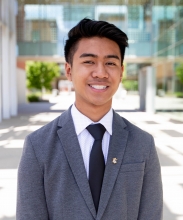 |
Major: Human Biology
Home City: Northridge, CA
Contact: jlibang@ucmerced.edu
Faculty Mentor: Jennifer Manilay
|
Jeremy Libang is a fourth year undergraduate student from Northridge, California. Expected to graduate in the Spring 2020 with a BS in Human Biology. Jeremy has made his mark at the University of California, Merced through scientific research and other activities. As an officer of Pi Lambda Phi Fraternity, President of Bobcat Gaming, Student Brand Ambassador for Kaplan Test Prep, and Resident Assistant, Jeremy has had the courage to follow his convictions and has attempted to make an impact at UC Merced as well as in the lives of his colleagues. In his free time, Jeremy enjoys playing League and watching basketball. Jeremy aspires to achieve a PhD in Microbiology, Immunology and Molecular Genetics and to ultimately become a professor who strives to inspire tomorrow’s scientists.
Identifying Natural Killer Cell Ly49 Subset Development in Vitro
Jeremy Libang, Albert J. Millan, and Jennifer O. Manilay, PhD; School of Natural Sciences, University of California, Merced
Natural Killer (NK) cells recognize and terminate virally infected and cancerous cells. Evidence shows Ly49 receptors play an important role in target cell recognition, but how NK cells acquire Ly49 receptors is incompletely understood. Ly49 activating and inhibitory receptors are membrane-bound glycoproteins encoded by genes in murine NK cells, thought to be expressed stochastically. We suggest an alternative hypothesis: Ly49 receptor expression is tightly regulated and sequentially forms unique NK cell subsets over time. We developed an assay in which we stimulated immature NK cells (CD27+CD11b-) in vitro to identify 16 possible combinations (clusters) of activating Ly49D and Ly49H, and inhibitory Ly49I and Ly49G2 receptors over time using flow cytometry. Our data identifies four novel clusters that significantly differ in frequencies over a period of six days in culture. We predict from frequencies a sequential cluster pathway that may originate from “Cluster 11” (Ly49H+Ly49D-Ly49G2-Ly49I+) which develops into “Cluster 14” by downregulating Ly49H, and then develops into “Cluster 8” (Ly49H-Ly49D-Ly49G2-Ly49I-) by downregulating all four receptors. We then predict “Cluster 8” to upregulate Ly49D and Ly49G2 to develop into “Cluster 6” (Ly49H-Ly49D+Ly49G2+Ly49I-). To test this, we will sort and culture these clusters to determine the trajectory of development for each cluster over time. These data provide evidence of controlled regulation of Ly49 receptor expression on NK cells, which may indicate expression is not stochastic.
Luis Maldonado
Luis Maldonado is a rising fourth year undergraduate student from Sacramento California. He is expected to graduate in Spring of 2020 with a Bachelor’s Degree in Applied Mathematics with an emphasis in Economic studies. As a student at UC Merced, Luis has been a part of impactful clubs such as Rotaract, a Community service club, and the Investment club where he is able to attain further knowledge on finances and the economy. During his free time, he enjoys listening to music and skateboarding, as well as playing Basketball. For Luis, a big goal he is looking forward to achieving is attaining a PhD in a field that will be of great impact to not just his life, but the rest of his community as well. He is motivated by his ability to become a role model for his family, and inspiring the future generation.
Solving Partial Differential Equations using the Least Square Regression Method
Luis, Maldonado, Maxime Theillard, and Arnold D. Kim, PhD; School of Natural Sciences, University of California, Merced
Least-squares regression (LSQR) has been used extensively for modeling data. For that problem, we seek to approximate a polynomial that best fits a data set by minimizing the misfit of the model to the data. We review this method and apply it to model several examples of stock prices. We then present our new LSQR based numerical method for solving boundary values problems for differential equations. Compared to traditional discretization techniques this new method offers the following advantages: (a) the implementation is straightforward (b) adaptive grids are easily handled (c) high order discretizations can be easily constructed. This new approach opens up the possibility of developing simple, efficient, and novel computational methods to simulate real-world phenomena with high accuracy at a minimal implementation cost.
Valerie Moss
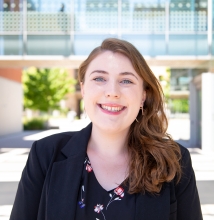 |
Major: Psychology & Cognitive Science
Home City: Modesto, CA
Contact: vmoss@ucmerced.edu
Faculty Mentor: Meaghan Altman
|
Valerie Moss is a fourth-year undergraduate student from Modesto, CA. In Spring 2020, Valerie is expected to graduate with a BA in both Psychology and Cognitive Science. Valerie has been involved in various research projects on campus, ranging from her research for the Consortium for Research on Atypical Development and Learning Lab (CRADL) and the Office of the Associate Vice Chancellor and Dean Students, as well as helped begin a relationship with MacNamara Youth Center in South Merced. Outside of researching, Valerie has been a Tour Guide for the Office of Admissions, is the former Chief Justice of the ASUCM, and is looking forward to starting a new journey in Fall 2019 with CITRIS. After graduation, Valerie hopes to attend graduate school to receive her Ph.D. in either educational or social psychology which she will take into the educational policy field! She hopes to take her experiences in higher education to create an impact on the future of higher education.
Evaluating the Effectiveness of Emotional Stimuli in the Conners Continuous Performance Task III
Valerie N. Moss, Meaghan Altman, PhD, and Alexander Khislavsky, PhD; School of Social Sciences, Humanities, and Arts, University of California, Merced
Attention influences an individual’s ability to respond to their environment. Conners Continuous Performance Task III (CCPT-3) focuses on measuring an individual’s attention and inhibition to serially presented visual stimuli (i.e. letters) (Conners, Pitkanen, Rzepa, 2014). The following study was developed by our lab to validate a new measure: the Emotional Continuous Performance Task (EMO_CPT). This task maintained the parameters established by the CCPT-3, excepting that this measure uses a standardized battery of emoticons instead of letters. Participants experience one of two counterbalanced conditions where they respond to a specific valanced emoticon via a keystroke and are asked to refrain from a response when a differently valanced emoticon is present. The EMO_CPT was standardized by establishing the unidimensionality, discriminative validity, and test-retest validity of our four measures. The results of repeated measures ANOVA’s revealed no significant differences between either EMO_CPTs. Two-tailed independent t-tests, between the EMO_CPT and the CCPT-3, revealed several significant differences suggesting that there are relevant differences between these two measures. Pearson correlation comparisons exhibited an increased relationship in missed target stimuli between time one and time two for participants in the EMO_CPT versus that of the CCPT-3. The results from this study suggest that the EMO_CPT may be capable of evaluating metrics which are inaccessible with the standard CCPT-3.
Gabriel Nguyentran
Gabriel Nguyentran is a rising fourth-year undergraduate from San Jose, California. He is expected to graduate in Spring 2020 with a Bachelor of Science in Cognitive Science and a minor in Psychology. Despite starting at UC Merced in the Fall of 2018 as a transfer student, Gabriel has quickly made the most of his opportunities, and has been a research assistant in Michael Spivey’s lab since the Spring of 2019. To relax, Gabriel likes to watch movies (which range in genre and even language!), read books, play video games, and hang out with friends. Gabriel hopes to achieve at least a M.A. in the Psychological Sciences or Cognitive Science after graduating from UC Merced.
The Relationship Between Socioeconomic Status and False-Belief Understanding
Gabriel T. Nguyentran, James Sullivan, and Rose M. Scott, PhD; School of Social Sciences, Humanities, and Arts, University of California, Merced
False-belief understanding, which is the cognitive ability to recognize that other individuals can be mistaken, can be impacted during development by socioeconomic status (SES). Previous studies have confirmed that there is a positive correlation between a family’s SES and their child’s performance on elicited-response false-belief tasks. However, failure on those tasks can be explained by a number of reasons, such as difficulty in inferring false-beliefs, predicting behavior, or answering direct questions about the mistaken behavior. Our project will utilize a multi-method approach that will disentangle those sources of failure, thus, clarifying the nature of socioeconomic disparity in false-belief understanding. Child participants, between 3.5 and 5.5 years old, will complete elicited and non-elicited response false-belief tasks and several other cognitive assessments. Their parents will complete questionnaires about family demographics, their stress levels, and knowledge of child development. Parent-child pairs will complete interactive tasks that will evaluate the parent’s use of language. Preliminary results imply that including non-elicited response tasks will help yield new insights into the nature of SES-related disparities in false-belief understanding. Preliminary studies also suggest that a child’s verbal ability and their parent’s use of mental-state language are positively associated with the child’s performance on non-elicited response false-belief tasks. These findings will advance knowledge about the nature and causes of SES-related disparities in the development of socio-cognitive abilities.
Liza Oh
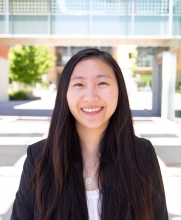 |
Major: Psychology
Home City: Cerritos, CA
Contact: loh6@ucmerced.edu
Faculty Mentor: Rowena Gray
|
Liza Oh is a fourth year undergraduate student from Cerritos, CA, who is expected to graduate in Spring 2020 with a BA in Psychology. Liza has been focusing on machine learning and coding neural networks in PyTorch with a Cognitive Science professor at the University of California, Merced. She has also been getting more involved in research and is a part of the Health Communications and Interventions Lab at UC Merced as a research assistant. In her free time, Liza enjoys crocheting and playing the ukulele. She plans on attending graduate school and hopes to work at a national laboratory to do research that will benefit the public.
In-Depth Analysis of Minimum Wage Workers from 1940 to 2000
Liza Oh, Raymond Kim, and Rowena Gray, PhD; School of Social Sciences, Humanities, and Arts, University of California, Merced
This study sought to explore what types of people work minimum wage occupations through analyzing minimum wage worker demographics. These demographics were found in U.S. Census data from 1940 to 2000 and included variables such as age, gender, race, and family size. The issue this study sought to investigate was whether or not minimum wage workers changed during this time period. This study found that minimum wage workers became more diversified in race and age, shifted from being predominantly men to predominantly women, and had a relatively consistent family size from 1940 to 2000. Knowing what types of people work minimum wage occupations will give insight into how the labor market is split demographically and who is affected the most by changes to the minimum wage and minimum wage laws.
Candydo Orosco
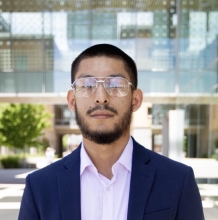 |
Major: Management and Business Economics
Home City: Fresno, CA
Contact: corosco2@ucmerced.edu
Faculty Mentor: Melissa Sands
|
Candydo Orosco is a fourth-year first-generation undergraduate student from Fresno, CA. Expected to graduate in Spring 2020 with a B.S. in Management and Business Economics and a minor in Political Science. After graduating he aspires to attain an MPA in Policy and Economic Analysis and a Ph.D. in Statistics right after. He then plans to take that knowledge back to his community and become involved in city politics and hold a government position such as mayor, senator, or representative. By holding a government position he will strive on helping low-income people of color start businesses, become financially literate, improve educational opportunities for his constituents and advocate for police transparency and accountability due to his traumatizing encounters with the local police. To achieve these goals he plans on holding city council or city management positions while in graduate school. In addition, he is currently co-authoring a research paper on whether exposure to inequality affects support for redistributive public policies alongside Professor Melissa Sands. Subsequently, he has started to do independent research on policing to prove there are issues in places out of sight and out of mind like where he bloomed from. Coming from a low-income high crime area without any guidance he put all his eggs in one basket and invested in education as his only form to escape his environment and looked up to historical figures such as Malcolm X and Cesar Chavez for inspiration. A life accomplishment that sticks close to his heart is when he moved from SouthEast Fresno to a ghetto in SouthWest Fresno entering the 3rd grade as an English learner. That school year he quickly learned the English language, adjusted to his surroundings and went on to win the spelling bee and achieved perfect attendance causing other students to look up to him. He was motivated to start tutoring students from his grade and those below in test preparation and homework, and these events eventually led on to his elementary school gaining more funding as student state test scores kept rising since the year he arrived. Before moving back to SouthEast Fresno after the 6th grade he was offered a page in a book with his own biography written by his 6th-grade teacher to spotlight his achievements. Another life accomplishment he is proud of is funding his own higher education by working in the fields during the summer and penny pinching his money since his many hustles as a child from recycling metals, cardboards, fixing pallets, and selling at the flea markets during weekends. To destress he likes to work out and listen to Mozzy and Tsu Surf in which their struggles, and pain he can relate to and find peace. His personal goals include owning his own property and businesses, attaining financial freedom through passive income, and through his autobiography inspire others who can relate to his struggles turn nothing into something through the power of higher education and self-love while remaining humble and paying it forward.
Does Trump's Anti-Immigrant Rhetoric Lead to Greater Bias in Police Actions?
Candydo Orosco, and Melissa Sands, PhD; School of Social Sciences, Humanities, and Arts, University of California, Merced
Over the past century, the Latin community has been the target of various negative political rhetoric and anti-immigrant sentiment. From being intertwined with marijuana to push anti-immigrant propaganda back in the 20th century to now being targeted by Donald Trump’s anti-immigrant rhetoric. The negative views on the Latin community can lead to the Latin population facing a cycle of issues such as fear to leave their house, and police distrust. This research uncovers how Donald Trump’s anti-immigrant rhetoric has impacted policing actions against the Latin community among locations with high vs low support for Trump. The data in this research was gathered through GIS maps displaying support for Trump during the 2016 election and data from Stanford’s Open Policing project to spot a bias. To help solve the ongoing issue of policing within the United States, there are many actions to be taken. This includes having a representative bureaucracy within city politics, ensure that there is police accountability by means of the supreme court, and police transparency to continue to conduct this type of research.
Megan Pinkus
 |
Major: Environmental Engineering
Home City: Riverside, CA
Contact: mpinkus@ucmerced.edu
Faculty Mentor: Martha H. Conklin
|
Megan Catherine Pinkus is a third-year undergraduate student from Riverside, CA. Expected to graduate in Spring 2021 with a BS in Environmental Engineering, Megan has already begun to make an impact at the University of California, Merced by conducting research and being an active member in her community. Megan’s academic goals are to explore the fields of hydrology and sustainability. As a brother of Theta Tau, Megan thinks it is important to give back to her community by volunteering her time, talents and influence to the places that she can make the greatest contribution. To destress, Megan finds herself listening to music and doing spontaneous things with her friends. She aspires to achieve a PhD in Civil Engineering, and her ultimate goal is to be a woman who can inspire youth from low-income households to pursue their dreams and encourage them to a life in higher education.
Evaluating Soil Moisture and Vegetation Patterns Over Time through COSMOS
Megan C. Pinkus, Erin Stacy, and Martha Conklin, PhD; School of Engineering, University of California, Merced
Measuring soil moisture is an important factor in understanding how our natural environment functions and responds to change. We want to understand the behavioral patterns of vegetation and soil moisture within multiple areas and detect their similarities and differences throughout the years June 2011 to June 2019. We gathered approximately 160 sample points by hand in 8 different directions from the flux tower that has a COsmic-ray Soil Moisture Observing System (COSMOS) probe attached to it. This system allows us to view the area-average of soil moisture through the hectometer horizontal scale. This system carries a probe that measures the neutrons that are created by the cosmic rays that lie within the soil, air, and other materials. COSMOS is utilized in order to evaluate the contributing factors besides snowmelt that affect soil moisture. Considering the elevation and location of the stationary system, there is a drought and mortality event occurring near the tower located in Providence (P301) where a massive part of the forest has died off. We aim to see the accuracy of this instrument and view how close our results are to the data points collected from the tower through a series of graphs. This will guide us to discovering how soil moisture and vegetation patterns change over time.
Stephanie Reyes
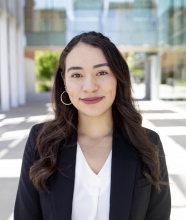 |
Major: Psychology
Home City: Los Banos, CA
Contact: sreyes33@ucmerced.edu
Faculty Mentor: Matthew Zawadzki
|
Stephanie Reyes is an aspiring third-year student from Los Banos, CA. She is expected to graduate in Fall 2020 and obtain a Bachelor of Arts in Psychology with a Public Health minor. After graduating, Stephanie is hoping to be accepted to graduate school to be able to obtain a Ph.D. in Clinical Psychology while focusing on improving mental health among various communities. To better prepare herself for her future goals, Stephanie is currently focusing on beginning her journey as an undergraduate researcher. This summer, Stephanie will be working in Professor Matthew Zawadzki’s lab where she will be focusing on how experiences of daily stress are influenced by personal characteristics. In addition, Stephanie has also been a continuing research assistant (RA) in Professor Wiebe’s lab and the Translational Research Center under the Health Sciences Research Institute at UC Merced. Moreover, growing up in the Central Valley, Stephanie hopes that she can help communicate the importance of mental health among communities and potentially decrease the occurrence of mental illnesses throughout her future endeavors. Moreover, to de-stress, she typically enjoys spending time with her close friends and family and also enjoys visiting new places.
Differences in Emotional Reactivity and Perceptions of Stress Inensity after Exposure to Stressful Life Events Among Adults
Stephanie R. Reyes, Larisa Gavrilova, and Matthew J. Zawadzki, PhD; School of Social Sciences, Humanities, and Arts, University of California, Merced
Exposure to stressful life events may lead to different emotional reactions among adults, such as feeling anxious, sad, or angry. People may also report different perceptions of stress intensity that can influence different emotional reactions. It is unclear, however, if different age groups experience stress the same. This project seeks to understand the relationship between exposure to stressful events, perception of stress intensity, and emotional reactivity based on age. The sample consisted of 315 working adults, including 71 men, 208 women, and 36 other/unanswered responses, between the ages of 18 - 66 at the University of California, Merced. Perceived stress intensity, emotional reactivity, and exposure to a stressful event in daily life were assessed using Ecological Momentary Assessment (EMA) up to five times a day for four consecutive days. Based on prior research demonstrating that ageing is associated with a decrease in emotional intensity and negative emotional reactivity (Gross et al., 1997), we anticipate that younger adults will report higher levels of perceived stress intensity when exposed to stressful events compared to older adults. By examining the relationship between exposure to stressful events, perceived stress intensity, and emotional reactivity reported, we will have a better understanding of how age plays a role in the perception of everyday life stressors.
Madison Reyna
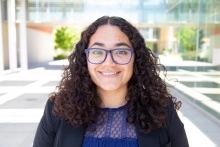 |
Major: Psychology
Home City: La Puente, CA
Contact: mreyna4@ucmerced.edu
Faculty Mentor: Jennifer Howell
|
Madison Reyna is a fourth year undergraduate student from La Puente, CA. Expected to graduate in Fall 2019 with a BA in Psychology, Madison has begun to make her mark at the University of California, Merced by conducting research and being a member of the softball club representing the school across the state. Being a research assistant in the MESH Lab and a member of Psi Chi, Madison has gained an interest in research and the motivation to continue her education after receiving her BA. On her free time Madison likes to catch up on her favorite shows on Netflix and watch Dodgers baseball. After she graduates Madison plans on attending graduate school to receive a PhD in Clinical Psychology. She hopes to one day be able to able to work in a prison or a juvenile detention center.
Individual-Difference and Well-Being Correlates of Perceiving Multicultural Threat: Evidence from a Hispanic Serving Institution
Madison A. Reyna, Angela Johnson, MA, and Jennifer Howell, PhD; School of Social Sciences, University of California, Merced
Multiculturalism is the coexistence of multiple cultures and ethnicities in a society. Those living in multicultural environments experience a host of positive outcomes, including better academic performance, improved psychological well-being, and increased empathy toward others. Nevertheless, some people perceive multiculturalism as a threat to their own group’s opportunities for success; that is, they perceive multicultural threat. The present study examines perceptions of multicultural threat in a highly multicultural environment (at a Hispanic Serving Institution) to address two primary questions: (1) Who perceives multicultural threat? and (2) How does perceiving multicultural threat relate to health and well-being? A sample of 405 undergraduate volunteers at the University of California, Merced completed an online survey in which they reported perceptions of multicultural threat, demographic characteristics, personality traits, and health/well-being. Results suggested that women, those with higher subjective SES, those lower in agreeableness, and those lower in emotional stability were most likely to perceive multiculturalism as threatening. By contrast, Latino/a/x and first-generation students were the least likely to perceive multiculturalism as threatening. To the extent that people perceived multicultural threat, they also reported more stress, anxiety/depression, and sleep disruption, as well as a lower sense of belonging at the university. These findings offer initial insight into who perceives multicultural threat and suggest that such perceptions relate to poorer health and well-being in a diverse, multicultural environment.
Jesus Salas Hernandez
Jesus Salas Hernandez is a third-year undergraduate student from Los Angeles, Ca. He is currently pursuing a Bachelors of Science in Environmental Engineering and is expected to graduate in Fall 2021. Jesus has constantly strived to improve himself and leave his mark on the UC Merced community. He has demonstrated this commitment through his involvement in the Solar Energy Association and Engineering Service Learning. Additionally, Jesus is also passionate about empowering disadvantaged communities to achieve higher levels of education. He was able to work towards this by working with the Center for Educational Partnerships. Jesus was given the opportunity to tutor/mentor middle school students from Delhi, CA. To destress, Jesus enjoys going backpacking, learning new songs to play on his guitar, and discovering new music. He aspires to obtain a master’s degree in environmental systems and his utmost goal is to contribute to the conservation/restoration of National Parks.
Methane Adsorption Capacity of Activated Carbon and Biochar
Jesus Salas Hernandez, Sai Phani Kiran Hota, and Gerardo Diaz, PhD; School of Engineering, University of California, Merced
Dairies are the single largest contributor of California’s anthropogenic methane production. Approximately, 11.67 MMT CO2e, constituting 34% of total agricultural emissions, are generated from manure management. Biochar is a porous material, that may be included during composting in order to reduce natural gas discharges, up to 32% in methane emissions, and aerate the mixture. This study focuses on biochar which, due to its surface area, has been demonstrated to be an effective material for the adsorption of natural gas. Compared with other adsorbents, biochar still exhibits non-optimal performances for industrial usage. Activation of biochar has become standard practice for enhancing the surface area and micro-porosity, yet there exists insufficient research on the effects of chemically activated biochar on methane adsorption. The objective of this research is to analyze how chemical activation of biochar enhances methane adsorption capacity. The physical properties of the biochar samples were obtained utilizing a Gemini VII 2390 Surface Area Analyzer; data analysis was completed via the Brunauer- Emmett-Teller method. A dynamic fixed-bed adsorption column was designed for obtaining breakthrough curves and adsorption capacities for each adsorbent. The activated carbon from biochar is predicted to exhibit a greater surface area and micropore distribution compared to that of the control sample. Breakthrough time for the activated biochar is anticipated to be longer than for the untreated samples, indicating a greater adsorption capacity.
Steven Soe
 |
Major: Bioengineering
Home City: Oakland, CA
Contact: ssoe@ucmerced.edu
Faculty Mentor:
|
Steven Soe is a third year undergraduate student from Oakland, CA. As a first-generation student, Steven is expected to graduate in Fall 2020 with a BS in Bioengineering. Steven has already made his mark at the University of California, Merced by conducting research and being an active member in his community. As the president of Biomedical Engineering Society (BMES) and program management chair at Vanguard, Steven is continuously on the search to help people to grow academically and professionally in the world of engineering. Steven is also a part of the Greek life on campus as a member of Kappa Sigma, a fraternity who's has a core principal for giving back to the community, whether it is raising money for military heroes, reading to elementary kids and more. To distress, Steven participates in hobbies such as, cooking or hanging out with friends by going to music festivals or playing sports. He aspires to achieve a Master's Degree in Bioengineering, and his ultimate goal is to be a leader in the industrial world by designing cheaper and more effective biotechnology.
Enhanced Luminescence Imaging with Ultrasonic Waves
Steven Soe, Yile Fang, Changqing Li, PhD; School of Engineering, University of California, Merced
Luminescence imaging such as fluorescence imaging and bioluminescence imaging has been used to obtain the bio-distribution of luminescent agents inside tissues by measuring the emission optical photons on the tissue surface. However, the spatial resolution of luminescence imaging is compromised in deep tissues due to strong optical scattering. Generally, the spatial resolution is less than 1 millimeter when the imaging depth is larger than 1 mm. In this study, we proposed to enhance the spatial resolution of luminescence imaging by stimulating the emission with ultrasonic waves to obtain a spatial resolution close to the focal spot of ultrasound imaging, which is up to 0.4 millimeters. In further detail, after the luminescent agent, Strontium aluminate europium and dysprosium doped, is brought to an excited state by a UV light, ultrasonic waves are applied to the luminescent agent relieving the agent back to a ground state hours later. As luminescent energy is released, optical photons are emitted to be measured for luminescence imaging. If we used a focused ultrasound beam to control the energy-releasing region, we expect to obtain the luminescence imaging with a spatial resolution close to the ultrasound focal spot size. Through experimentation, the data supports our hypothesis as it displays a brighter luminescence over a shorter lifetime. Further research will be focused on building the enhanced luminescence imaging system with ultrasound waves.
Oscar Torres Gutierrez
Oscar Torres Gutierrez is an incoming fourth-year undergraduate student from Bakersfield, CA. He is majoring in Human Biology with a minor in Cognitive Science and is expected to graduate in Spring 2020. Oscar is beginning his research late in the University of California, Merced but is making up the time he lost with full effort and enthusiasm. Oscar likes to listen to music daily and watch the Office at least once a year for fun and relaxation. He aspires to study the human brain in the future and wishes to one-day cure neurodegenerative diseases.
Inducing Biotin Deficiency in Pregnant Mice
Oscar Torres Gutierrez, Xuecai Ge, PhD, and Xiaoliang Liu, PhD; School of Natural Sciences, University of California, Merced
This project serves as part of an ongoing proteomic study that aims to reveal bona fide cilium proteins in the developing brain. Our preliminary study showed that the endogenous biotinylation level is high in the brain, which prevents the isolation of cilium specific proteins from cilium-TurboID transgenic mouse. The goal of this project is to identify a time window in which biotin levels are reduced in the brain without significant impairment of brain development. To achieve this goal, we ordered 16 pregnant mice (Strain C57BL/6). 8 mice were fed biotin depletion food and the other 8 were fed normal food. The mice were then sacrificed at different stages (E8-E18) and the embryonic brains were dissected. The brains were either snapped freeze in liquid nitrogen or preserved in 4% PFA. The protein biotinylation levels were evaluated with Western Blot procedure. To evaluate the effect of biotin deficiency on brain development, we used immunostaining to observe the neocortex structure. Our result will provide important information for the overall experimental scheme of in vivo cilium proteomics. It may also contribute to better understanding of biotin deficiency-related deficits such as cleft palate.
Osvaldo Valencia
Osvaldo Valencia is a fourth year undergraduate student at UC Merced from San Jose, CA. He is expected to graduate in Spring of 2020 with a BA in Political Science. As an undergraduate, Osvaldo got to participate in the University of California, Washington Program (UCDC) during the Fall of 2018 and there he had the pleasure to intern at the University of California Federal Governmental Relations Office. There, he learned about advocacy done on behalf of/in conjunction with students as well as the process of legislation. Osvaldo also has the pleasure of being the current administrator of the UC Merced Law Clinic, which strives to bridge the gap between students and the legal world. After he graduates, Osvaldo hopes to get a Master of Public Policy in order to best serve the public. His ultimate goal is to either work in the legislature (either federal or local level) or at a non-profit.
Urban/Rural Divide in Politics
Osvaldo A. Valencia, and Adi Dasgupta, PhD; School of Social Sciences, Humanities, and Arts, University of California, Merced
Today, rural counties in the United States are consistently more conservative in elections than are urban areas. Common explanations for this phenomenon point to the cultural conservatism of rural voters. However, it is worth asking, was rural America always politically conservative? A look at history suggests that the conservative turn in rural America occurred relatively recently, during the middle of the twentieth century. This research examines quantitatively when a correlation between rural areas and support for conservative politicians emerged in the United States by assembling a new dataset connecting census data and election data for all American counties between 1900 and 2000. Using digitized maps of major events such as the Dust Bowl, it will also conduct an exploratory analysis of historical events which may have influenced this shift. Preliminary results show that in Texas a correlation between the percentage of the population located in rural areas and the vote share of the Republican party emerged only after the 1980s. We hypothesize that the conservative turn in rural America is a relatively recent phenomenon in other states as well. We also hypothesize that the earliest correlation between rural areas and support for conservative politicians began during the Dust Bowl. The goal of this research is to serve as a steppingstone for future researchers to explore the importance of these events by providing a dataset on ruralness and support for conservative politicians for all American counties for the period 1900-2000.
Phalen Vang
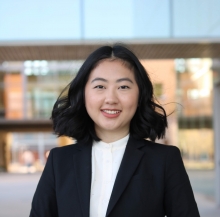 |
Major: Biological Sciences
Home City: Clovis, CA
Contact: pvang47@ucmerced.edu
Faculty Mentor: Gordon Bennett
|
Phalen Vang is a Third-Year undergraduate student from Clovis, CA. Expected to graduate spring of 2021 with a BS in Biology, Phalen has committed to connecting with her community and striving for excellence here at the University of California, Merced. As an officer of AMSA, a member of SURF while conducting research, and volunteering at Hmong health clinics in Fresno, CA, Phalen believes that education is a valuable experience that the nation has to offer, as well as kindness to others in her community. Phalen strives to become a leader and a mentor to the future generations through her volunteer work and greater contributions for her community. Phalen spends her time with family and friends in her free time. She aspires to achieve a Ph.D. in cellular biology and inspire others in her community to pursue higher education.
Epigenetic Sequencing of Bacterial Microbes in Mammals
Phalen N. Vang, Meng Mao, PhD, and Gordon M. Bennett, PhD; School of Natural Sciences, University of California, Merced
Most animals establish symbioses with bacteria that provide essential health benefits. In particular, bacteria offer nutritional metabolisms that hosts require, and in return hosts provide genetic and cellular support of the bacteria. However, the mechanisms that hosts use to regulate bacterial symbiont activities remains uncertain. One possible host regulatory mechanism is to control support genes so that they are expressed exclusively in symbiont organs (bacteriomes) where bacteria reside. This regulation may occur through epigenetic modification of genes via methylation. Methylation is essential for cell differentiation via repression of gene expressions, blocking promoters where transcription factors should bind. How, or if, animals use methylation to regulate interactions with bacterial partners remains unclear. We hypothesize that hosts methylate symbiont support genes in non-symbiotic tissues, allowing them to uniquely express them in the bacteriomes. To test this, we focused on the leafhopper, Macrosteles quadrilineatus (MAQ), that harbors two bacterial symbionts, Sulcia and Nasuia. Recent work showed that MAQ specifically expresses thousands of genes to support these bacteria, which are likely to be under epigenetic control. To date, MAQ specimens were collected from laboratory-reared lines. Head, leg, and bacteriome samples were dissected from 50 pooled females in three replicates. DNA extraction was performed and methyl-bisulfate sequencing is underway. We predict that epigenetic control, is a common mechanism to regulate the bacterial symbionts of animals.
Emily Wang
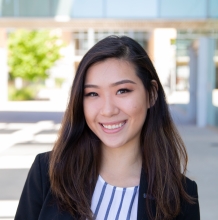 |
Major: Cognitive Science
Home City: Irvine, CA
Contact: ewang36@ucmerced.edu
Faculty Mentor: Ramesh Balasubramarian
|
Emily Wang is a fifth-year undergraduate student from Irvine, CA. Expected to graduate in Fall 2019 with a Bachelor of Science in Cognitive Science, Emily has been heavily involved in student life at the University of California, Merced since her freshman year. Emily co-founded Bobcat Model United Nations, the school’s first traveling debate club, and later joined Cognitive Science Student Association. Emily's various leadership positions include Undersecretary-General of Technology and USG of External Affairs for Bobcat MUN, Events Chairman for Kappa Kappa Gamma fraternity, and Director of Logistics for HackMerced. She also recently studied abroad in Taiwan, where she volunteered as a museum docent for the National Taiwan Museum in order to immerse herself in the local culture and history. When she is not planning events for her extracurriculars, Emily can be found in Professor Kello’s Cognitive Mechanics lab running participants and supplying graduate students with homemade desserts. While she is interested in working in the video game industry as a UX researcher, Emily aspires to obtain a PhD in cognitive science and hopes to inspire a new generation of cognitive scientists by becoming a professor at a research university.
Differences in Motor Movements During Implicit and Explicit Learning of Motor Sequences in a Serial Reaction Time Task
Emily Wang, Alexandria Pabst, and Ramesh Balasubramaniam, PhD; School of Social Sciences, Humanities, and Arts, University of California, Merced
Implicit and explicit procedural learning differences have widely been studied in motor sequence learning paradigms utilizing button-presses. In this exploratory study, we aim to resolve if changes in the perceptual nature of stimuli in a serial response time task adapted for manual movements of the arm change aspects of movement during implicit and explicit learning of a motor sequence. Using the KINARM™ exoskeleton and an eye tracker, participants were asked to make back and forth movements using their right arm towards 8 targets surrounding a starting position while their gaze was recorded. Participants were separated into implicit learning and explicit learning groups and small perturbations could be applied to the hands after reaching toward a target, pushing them in the direction of the next upcoming target during sequence blocks, enhancing predictive mechanisms. Initial data indicate that reaction times, peak velocity, and acceleration of movements during sequence learning across all conditions are slower compared to randomized trials, similarly found in Moisello et al.(2009), showing that motor learning requires additional cognitive processing and resources. We hope to confirm that the KINARM™ accurately replicates results found in traditional sequence learning tasks, in addition to further understanding how manipulating the perceptual nature of stimuli influence learning styles.
Teagan Zuniga
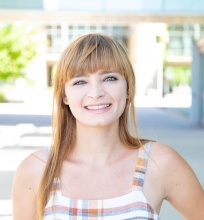 |
Major: Political Science
Home City: Modesto, CA
Contact: tzuniga3@ucmerced.edu
Faculty Mentor: Elaine Denny
|
Teagan Zuniga is a third year undergraduate student from Modesto, CA. As an undergraduate, she has been very active in the campus community. Teagan has been a part of the Undergraduate Research Journal, intramural sports, and Half Dome Community Council. In her free time, Teagan likes to watch movies with her friends, read novels, and play video games. She aspires to obtain a Masters Degree in Public Policy after she graduates from the University of California, Merced.
Assessing Crime, Delinquency and Violence: Resident Trust and Police Effectiveness in Guatemala
Teagan M. Zuniga, and Elaine K. Denny, PhD; School of Social Sciences, Humanities, and Arts, University of California, Merced
From 1960 to 1996, Guatemala faced an intense civil war that has left the population in a tense post-war world. With rising crime and poverty, what affects people's choice to stay in Guatemala or emigrate? 19,003 individuals were surveyed in person in a representative sampling of the Guatemalan population. This survey asked questions about Guatemalans' economic situation, their relationships with various types of organizations, and their likelihood of migration. Here, I analyze whether an individual’s economic situation or self-perceived likelihood of future violence drives the decision to migrate. A multivariate logistic regression shows that a person’s economic situation, their past experience of violence, and expectation of future violence all correlate with planning to migrate.



